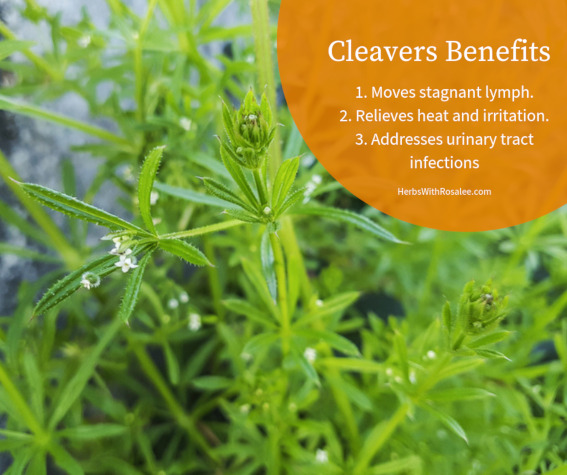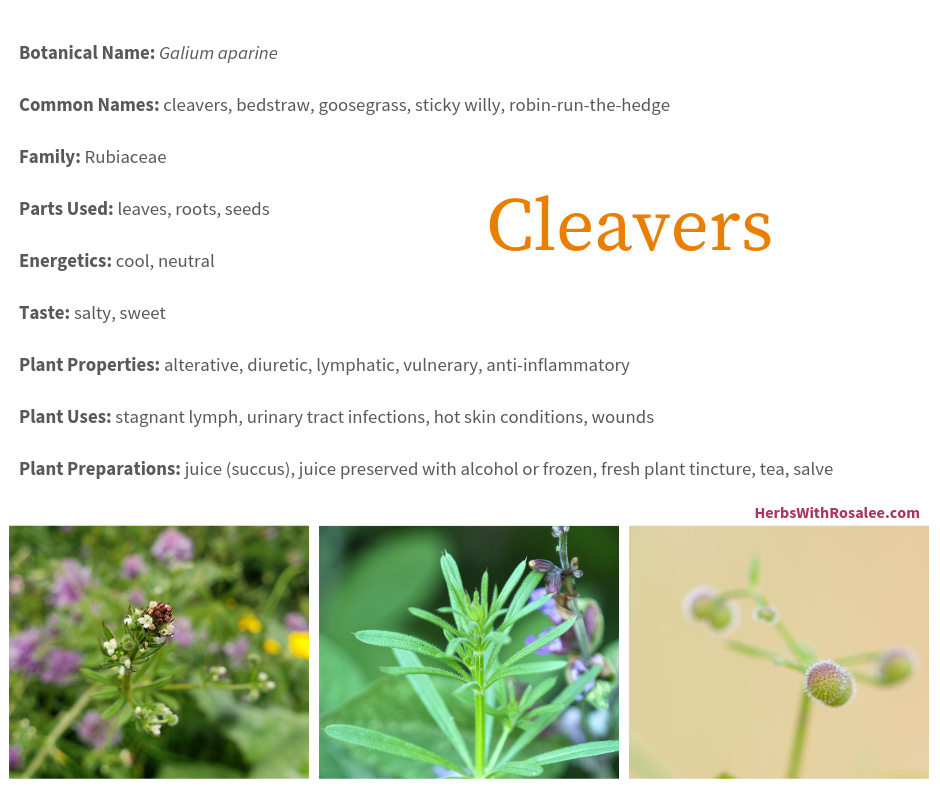Get weekly tips, recipes, and my Herbal Jumpstart e-course! Sign up for free today.

The Cleavers Herb
Share this! |
|
The cleavers herb gives us so many benefits! It’s a weed you can eat that also makes excellent medicine. One of my favorite things about cleavers is that this plant gives us medicine you can’t find the equivalent of at a drugstore. What drug provides minerals while also moving lymph? (And that’s just one of its many gifts!)
In this episode, I’ll also be showing you a favorite simple recipe for cleavers juice (or succus). It’s nutrient-dense, with a fresh, green flavor. You can sip it straight or blend it into other juices or smoothies. It can also be frozen or preserved, so even in winter you’ll have it handy to soothe a sore throat or get a boost of extra vitamins, minerals, and phytonutrients. There are so many tasty and beneficial ways to enjoy it! This is one you won’t want to miss.
After watching this video, you’ll know:
► When cleavers is good to eat (and when to avoid eating it)
► What types of health complaints cleavers is especially well-suited to help with
► When to check with a medical professional to rule out serious issues
-- TIMESTAMPS --
- 00:00 - Introduction to the cleavers herb (Galium aparine)
- 05:33 - Benefits of cleavers for the lymph
- 07:08 - Cleavers is a gentle, effective diuretic
- 07:35 - Cleavers for soothing inflamed skin
- 09:08 - Other gifts from cleavers
- 09:49 - Cleavers plant identification
- 11:26 - Cleavers recipe for a juice (or succus)
- 14:39 - Cleavers fun fact
Download Your Recipe Card!
l
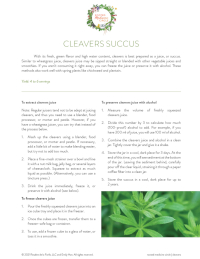
Transcript of the Cleavers Herb Video
Cleavers
is an herb of the spring. Its fresh growth is often one of the first
greens to arrive and it offers welcome food and medicine.
Cleavers
is a weed you can eat! And in just a bit I’ll share one of my favorite
cleavers recipes… but there is something to know about eating cleavers.
It is best when very young! Similar to burdock seeds, or even velcro,
the mature cleavers plant is covered in little hooks that help the
plant to grow tall by allowing it to grab on to other plants. It also
helps the plant to hitchhike to new and exciting places to spread its
seed.
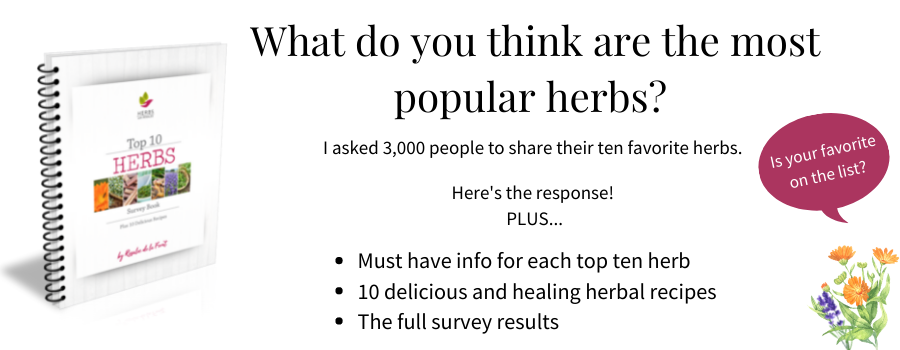
So once the cleavers herb develops these fine hooks on the leaves and stems and it makes it unpleasant to eat.
But those hooks also make this a fun plant!
The cleavers herb is a sticky sprawling plant long loved by children (and mischievous adults) for its ability to easily stick to clothing.
Have you eaten cleavers? Have you sneakily attached it to someone’s clothing when they weren’t looking? I’d love to hear more about your cleavers experience. Drop me a comment about cleavers - you never know when your experience can help others.
Okay, let’s dive in!
The first thing to know about cleavers is that this is a very cooling plant! This makes it ideal for hot and inflamed conditions. What I’m referring to in regards to cooling and hot are herbal energetics.
Whether this is your first video with me or your 14th, you should know that I love herbal energetics and consider this an essential part of herbalism. Without herbal energetics it’s hard to really know how herbs work and how to get the best results when working with them.
Okay, sure, you could simply memorize many of cleaver’s medicinal applications. However, you would be missing out on understanding its special affinities. Instead, when you apply simple herbal energetics you will have a deeper understanding of the cleaver’s plant benefits.
Here’s what I mean by that.
Cleavers is cooling and it excels when used to counteract hot conditions.
So, what’s a hot condition?
Hot conditions are characterized by signs of heat, including feeling hot, redness (or sometimes yellow), sharp pain, swelling, and inflammation. Burns are an obvious example of a hot condition as the burned area feels hot and turns red. An inflamed sore throat is another example of a hot condition and one that cleavers is especially well suited to address.
If you’re new to the concepts of herbal energetics and understanding if a plant or a condition is hot or cold or damp or dry then I have two resources for you.
The first is my free Herbal Jumpstart Course.
This short video course takes you through the ins and outs of herbal energetics and by the time you finish you’ll have increased your herbal knowledge 10 fold.
This course is entirely free to everyone who joins my herbal newsletter community. In addition to getting the free Herbal Jumpstart Course you’ll also hear from me every Wednesday with my best herbal tips and recipes. Sign up below!
Tired of herbal overwhelm?
I got you!
I’ll send you clear, trusted tips and recipes—right to your inbox each week.
I look forward to welcoming you to our herbal community! Know that your information is safely hidden behind a patch of stinging nettle. I never sell your information and you can easily unsubscribe at any time.
The second is my first book, Alchemy of Herbs: Transform Everyday Ingredients Into Foods and Remedies That Heal.
This
book shows you exactly how to choose herbs that are best for you, based
on herbal energetics. So if these concepts are new to you, check out
that book to get a foundational understanding.
Okay, back to the cleavers herb and its many benefits for hot and stagnant conditions.
The Cleavers Herb for the Lymph
Have you ever had swollen lymph glands? One of the most common experiences is feeling swollen lymph glands in your throat when you have a cold or other upper respiratory infections.
For simple lymphatic stagnation, the cleavers herb gently moves lymph. Cleavers can be used for both acute situations as well as long-term stagnations. It’s especially called for when the lymphatic stagnation is accompanied by signs of heat – for example, the affected area feels warm to the touch, with redness and/or swelling. Since cleavers comes out in the spring, it is also perfect for the sort of stagnation that builds up from the heavy foods and the potentially sedentary times of winter.
Of course, swollen lymph glands can be a serious sign, so it’s always a good idea to get that checked out by a medical professional to rule out complications, especially if the lymphatic swelling is sticking around for a while.
Cancer can affect the lymphatic system and there are many historical references to using cleavers for cancer. But, to date, there have been no human clinical trials involving cleavers in people with cancer.
However, there are many historical references to using cleavers for cancer. There are a small handful of in-vitro studies on a couple of Galium species that show promising results for head and neck cancers and breast cancers.1,2,3 It will be interesting to see how that research develops.
It is a supportive lymphatic therapy that can be useful for treating
long-term debilitating diseases when there is lymphatic congestion and
lymphatic tenderness.
Christa Sinadinos, 2012
Traditions in Western Herbalism Conference Class Notes
The Cleavers Herb as a Diuretic
Another benefits of the cleavers herbs is that it also gets things moving in the urinary system. This diuretic remedy is gentle and safe, even for children. Consider it especially when there are signs of heat, such as scant and scalding urine or bladder inflammation. For urinary tract infections (UTIs), consider pairing cleavers with uva ursi.
The Cleavers Herb for the Skin
Cleavers can be beneficial in many skin issues and can be used both internally and externally. Burns, including sunburns, can be relieved with the topical application of cleavers, either as a juice or a poultice.
Cleavers’ cooling and moving properties make it a good match for moist skin conditions that weep, especially with signs of heat. Robert Dale Rogers recommends it for psoriasis in combination with burdock root and yellow dock root. It can also be used for acne and boils.
I found an interesting historical article about cleavers and the skin published in The British Medical Journal written in 1883. It chronicled a patient with severe non-healing leg ulcers that didn’t respond to more common treatments. The doctor and author of the case study decided to try cleavers. He made a poultice out of the fresh aerial growths and applied it to the leg ulcers. The poultices were changed three times a day. He writes, “[Cleavers’] effect in this most unhopeful case was decisive and plain to all. Healthy action ensued, and has since steadily continued; and, after a month of treatment, both ulcers have been reduced to considerably less than half their original size.”5
Other Gifts from the Cleavers Herb
In addition to its many medicinal virtues, cleavers can be called upon for a variety of uses.
The very young plant can be eaten as a salad green. Avoid eating it as the plant matures and the hooks develop and become unpleasant to eat. See my interview with herbalist Angela Rahim where she shares using cleavers in omelets!
The seeds can be roasted and used to make a roasted-seed beverage.
The roots can be made into a red dye.
Whenever I encounter cleavers, especially in the early springtime, I
feel a palpable wave of refreshment wash through me, like taking a drink
from a cold mountain spring. And the plant literally glows before my
eyes—an aura of pure green health, if you will.
Meghan Gemma, Chestnut School of Herbal Medicine, Herbal Immersion Program
Botanically Speaking
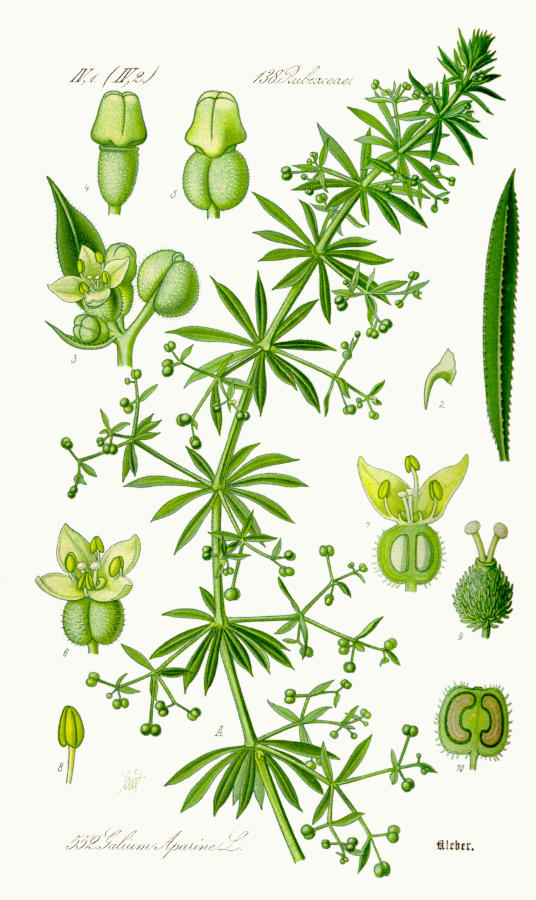
There are over 600 species of Galium. Many, but not all, are useful as medicine. Some notable medicinal species include sweet woodruff (Galium odoratum), and lady’s bedstraw (Galium verum).
This monograph is specifically about Galium aparine (cleavers).
Cleavers can be found all over the world in shady moist locations. If conditions are right, it will often grow in matted clusters.
It is an annual with square shaped stems. The leaves grow in a whorled pattern around each node, often six to eight in number. The leaves grow directly from the main stem.
The entire plant is covered in small hooks that allow the plant to cling to a variety of things, whether it’s growing over neighboring plants or adorning your clothing.
The tiny, white-to-green flowers have four petals and grow from the leaf axil.
It produces small sticky seeds that grow in clusters, often paired, which is a characteristic of the Rubiaceae family. The seeds easily catch on animal fur or clothing, helping with dispersal.
Cleavers is a very safe plant. However, rarely, some people may experience contact dermatitis after touching cleavers.
Cleavers Herb Recipe
With its fresh, green flavor and high water content, cleavers are wonderful when prepared as a juice, or succus.
Similar to wheatgrass juice, cleavers juice may be sipped straight or blended with other vegetable juices and smoothies. If you aren’t drinking it right away, you can freeze the juice or preserve it with alcohol. These methods also work well with spring plants like chickweed and plantain. I have done previous episodes on both of these plants, so if you’re interested in learning more about edible spring weeds, check those out.
The following recipe was written by Emily Han for our book, Wild Remedies: How to Forage Healing Foods and Craft Your Own Herbal Medicine. However, this recipe never made it to the book because we had to edit it down for length! So you can consider this a bonus recipe!
If you don’t already own Wild Remedies, this is an essential guide to learning about the edible and medicinal gifts of the plants that grow around you!
You can find it wherever books are sold and then visit WildRemediesBook.com to register for your exclusive bonuses like a three-part documentary highlighting many herbalists like Rosemary Gladstar and 7Song.
Okay, here’s how to make a succus with Cleavers:
1. Gather several handfuls of cleavers. Mash up the cleavers using a blender, food processor, or mortar and pestle. Add a little bit of water to make blending easier, but try not to add too much.
2. Place a fine-mesh strainer over a bowl and line it with a nut milk bag, jelly bag, or several layers of cheesecloth. Squeeze to extract as much liquid as possible. (Alternatively, you can use a tincture press.)
3. Drink the juice immediately, freeze it, or preserve it with alcohol.
For more tips on preserving your cleavers succus, download your free recipe card using the link the link above this transcript.
One thing to note is that regular juicers aren’t great at juicing cleavers, which is why we recommend using a blender, food processor, or mortar and pestle. However, if you have a wheatgrass juicer, you can try that instead.
Plant Preparations of the Cleavers Herb
Cleavers can be made into a fresh plant tincture. It is nutrient- and mineral-rich and nicely infuses into vinegar as well.
To capture the skin-healing qualities for an external application, infuse the wilted plants into oil for salves, creams, and serums.
The freshly dried plant can also be made into tea. Cleavers quickly loses its pizzazz when dried, so use the dried plant within a few months.
Dosage:
Fresh juice (succus): 1 teaspoon to 1/4 cup per day
Tincture or juice preserved with alcohol: 5-15 ml, three times daily
Tea: 10-30 grams
The King’s American Dispensatory says: “An infusion may be made by macerating 1 1/2 ounces of the herb in a pint of warm water for 2 hours, of which from 2 to 4 fluid ounces may be given 3 or 4 times a day, when cold.”6
Cleavers Herb Fun Facts
The cleavers herb is a healing medicine, a nutrient-dense food, and a clingy herb that entices you to be playful.
Obviously, one of the funnest facts about cleavers is how fun it is to see it get clingy on clothing and hair. But that cling factor has some other interesting uses.
When growing in clusters, cleavers clings together to form a dense mat. This was used as bedstraw (thus one of its common names). It was also used as a sieve to filter milk. This use may have led to the use of cleavers as a vegetable rennet for separating curds from milk to make cheese.
Citations for the Cleavers Herb
Click to show/hide.

Rosalee is an herbalist and author of the bestselling book Alchemy of Herbs: Transform Everyday Ingredients Into Foods & Remedies That Healand co-author of the bestselling book Wild Remedies: How to Forage Healing Foods and Craft Your Own Herbal Medicine. She's a registered herbalist with the American Herbalist Guild and has taught thousands of students through her online courses. Read about how Rosalee went from having a terminal illness to being a bestselling author in her full story here.
